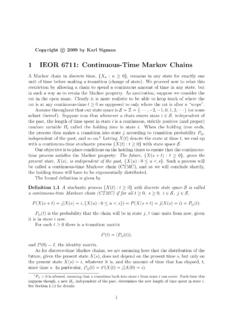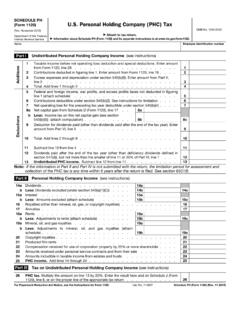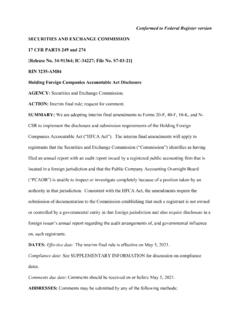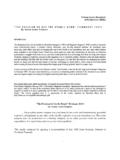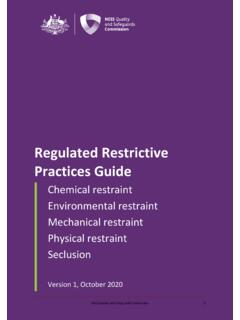Transcription of C. IRC 501(c)(2) - TITLE-HOLDING CORPORATIONS
1 C. IRC 501(c)(2) - TITLE-HOLDING CORPORATIONS1. IntroductionThe subject of TITLE-HOLDING CORPORATIONS has not been discussed in prior CPEtexts. But for the issue of multiple parents, it has been a relatively trouble-free records indicate that there are only approximately 5000 exempt title-holdingcorporations nationwide. However, we have seen a growing trend toward the useof these organizations as investment vehicles for pension plans and other exemptorganizations, and very substantial investments may be involved. This trend hasraised various technical questions in this area, the most important of which,concerning multiple parents, currently remains under study. This topic focusesprimarily on that 200 of IRM 7751, Exempt Organizations Handbook, contains atechnical discussion of this subject. See also p. 83 of the 1983 CPE text for adiscussion of the related question of feeder organizations denied exemption by BackgroundIRC 501(c)(2) exempts from federal income tax CORPORATIONS (as defined inIRC 7701(a)(3), " CORPORATIONS " include associations) organized for the exclusivepurpose of holding title to property, collecting income therefrom, and turning overthe entire amount thereof, less expenses, to an organization which itself is exemptunder IRC 501(a).
2 The statutory provision exempting TITLE-HOLDING CORPORATIONS has remainedsubstantially the same through successive enactments beginning with section 11(a)Twelfth of the Revenue Act of 1916, in which it legislative history surrounding the original enactment of the provisionmakes no specific reference to the provision or to the purpose it was intended toserve. The general observation is made, however, that organizations accordedexemption in the 1916 Act were difficult to secure returns from, and that theTreasury collected little or no revenue from them. (See H. Rep. No. 922, 64thCong., 1st Sess.)The statute has always authorized the turning over of income by title-holdingcorporations to any organization exempt under IRC 501(a) (or its predecessors),but we have been unable to find information indicating the numbers or kinds ofexempt organizations that may have utilized TITLE-HOLDING subsidiaries at the time ofthe original seems reasonable to assume that provision for the exemption of a TITLE-HOLDING corporation owned by an organization itself exempt from income tax wasmade by Congress in recognition of the existence of a number of factors that mightimpel an exempt organization to segregate its investments and property in separatecorporations.
3 These factors would include limitation of liability from potentialdamage suits; enhancement of ability to borrow; limitations imposed in gifts andbequests to exempt organizations that effectively require such gifts to be kept inseparate entities; clarity of title; accounting simplification; and limitations imposedby various state laws on organizations that would be recognized as exempt underthe federal revenue exemption provisions were enacted over a period of eighty years by avariety of legislators for a variety of reasons. While it is clear, in retrospect, thatmany of the provisions have long outlived their historic justification, it is also clearin contemporary application that many of them continue to play a very crucial rolein the law of tax-exempt organizations. IRC 501(c)(2) organizations, for example,currently provide a very popular means for unrelated IRC 401(a) pension trusts tocollectively hold title to property.
4 In addition, as one author has noted, "The TITLE-HOLDING company.. may be ideal for many organizations seeking a tax-exempthaven for their headquarters building. Presumably the tax writing committees ofCongress are not aware of the contemporary application of any of the statutes, andalso presumably, they and the Congress will most likely be content to maintain thestatus quo unless there is significant abuse." McGovern, "The ExemptionProvisions of Subchapter F," 29 Tax Lawyer 523, 547 (1976).In any event, beginning with the earliest interpretations of the statutoryprovision, it has never been questioned that only companies acting as investmentand holding companies, as opposed to operating companies, are exempt under thissection. Where the active operation of any business other than the rental of realestate has been involved, exemption has consistently been denied. In addition tothe exclusivity of purpose imposed by the statutory language and the evidencereflected in the precedents of a restrictive interpretation of the permissible ambit ofoperations for a TITLE-HOLDING corporation, there is evidence of a similarly restrictivephilosophy with respect to the permissible scope of a TITLE-HOLDING corporation'scharter powers - with the result that broad business powers in a charter havegenerally formed a basis for denial of exemption.
5 In our opinion, moreover, anycurrent applicant for exemption as a TITLE-HOLDING corporation should, as acondition of qualification, be required to submit appropriately restricted charterprovisions in this under IRC 501(c)(2) were first written in response to theRevenue Act of 1950, which imposed the unrelated business income tax on theseorganizations. These Committee Reports state that: "Since these organizations arepresently limited to holding title to property, collecting income from it, and turningthe proceeds over to other exempt organizations, the only trade or business inwhich they can engage is the rental of property." Thus, the rental of real propertywas clarified as being a permissible activity, which preserved the exemption fromtax for those TITLE-HOLDING CORPORATIONS already in existence that engaged in therental of real property by excluding them from the feeder provisions of IRC 502. Itshould also be noted that other types of investments are permissible, includingstocks, bonds, regulations also provide that an IRC 501(c)(2) organization cannot haveunrelated business income other than income which is treated as unrelated becauseof the application of IRC 512(a)(3)(C); or debt-financed income which is treated asunrelated because of IRC 514; or certain interest, annuities, royalties, or rentswhich are treated as unrelated because of IRC 512(b)(3)(B)(ii) or (13); and certainrents from personal property leased with real property which are treated asunrelated because of IRC 512(b)(3)(B)(i) or because of failure to meet the"incidental amount" exception in IRC 512(b)(3)(A)(ii).
6 An IRC 501(c)(2) organization formed by certain pension trusts andeducational organizations is not subject to the tax on income from debt-financedproperty under IRC 514(c)(9). See that section for the requirement to qualify Issue of Multiple Parents*_____* In this context the term "parent" has traditionally been used, perhaps somewhat loosely, to referto an organization that holds an interest in, but does not necessarily control, a corporation (orassociation within the meaning of IRC 7701(a)(3)).As stated above, a major problem currently in the area of IRC 501(c)(2) involves the issue of whether a TITLE-HOLDING corporation may have multiple parentsand, if so, under what issue was considered in GCM 33604 (8-28-67), in which a corporationorganized by ten lodges of a fraternal organization exempt under IRC 501(c)(8)was granted exemption under IRC 501(c)(2). The corporation held title to abuilding used in part by the lodges as their meeting hall and in part by commercialtenants on short term leases.
7 The GCM concluded that this type of mutualundertaking by the lodges of a single fraternal organization, so long as it isconfined to the operation and maintenance of real property, should not of itselfpreclude exemption under IRC 501(c)(2).The GCM observed further that there is a distinct break in the logic thatsupports exemption between the case of the holding company whose only asset is abuilding designed to provide quarters for one exempt parent or even severalexempt parents, and the holding company for, say, fifty different organizationsexempt under IRC 501 having in common only the fact that each owns someportion of a piece of rental property tenanted by unrelated third parties, title towhich is in a holding company for the fifty Ruls. 68-371, 1968-2 204 and 68-490, 1968-2 241, eachinvolved TITLE-HOLDING CORPORATIONS organized and operated for the benefit of twoexempt organizations, but, the relationship between the organizations is notdiscussed in either situation, and neither revenue ruling was addressed specificallyto the issue of multiple unrelated parents.
8 Briefly, Rev. Rul. 68-371 states that atitle-holding company will not continue to qualify for exemption when one of itstwo parents ceases to qualify, thereby recognizing implicitly that the existence ofmore than one parent is not per se disqualifying. Likewise, Rev. Rul. 68-490 holdsa TITLE-HOLDING company subject to unrelated business income tax if one of its twoparents is issue of multiple unrelated parents was again considered in GCM 37351(12-20-77). The organization described in this GCM was incorporated by a for-profit brokerage company to operate as a real estate investment trust in whichexempt organizations, primarily employee benefit pension trusts described in IRC401(a), were to be solicited to invest. The participating organizations were notrelated to each trusts were to be solicited to purchase or subscribe to shares of theorganization. The amounts paid by subscribers became the initial assets of theorganization, which could not commence operations until such time as a setminimum number of shares were issued.
9 The organization would then purchaseimproved real property, including office buildings, shopping centers, etc. Theincome from the rental of these properties was to be paid to the organization'sshareholders. The organization's articles of incorporation specified that its incomewould be paid at least annually to its shareholders and that if a shareholder lost itsexempt status, it must sell or otherwise transfer its shares to any other exemptorganization. Thus, the organization's articles attempted to conform to the obviousrequirements of the statute and of Rev. Rul. 68-371, discussed holding that the organization did not qualify for exemption under IRC501(c)(2), GCM 37351 referred to GCM 33604, supra, which dealt with themultiple ownership issue, and the fact that the organization would be engaged inthe business of operating a real estate investment trust. GCM 37351 referred to thelegislative history of IRC 501(f), which provides for the exemption of cooperativeservice organizations that invest funds for schools, stating:Section 501(f) is limited to organizations formed and controlled bythe investing educational institutions themselves, and is not toapply to any organization formed to promote the furnishing ofinvestment services by private interests even though those servicesmight be made available only to educational organizations.
10 In otherwords, if the schools that were involved formed their owncooperative investing organization, then it would be exempt underSection 501(f). However, if a private brokerage company orinvestment advisory company were to initiate the formation of acooperative investing organization, in order to obtain customers forits business, such an organization would not be exempt ..(Emphasis added.)It concluded that this was an expression of Congressional disapproval of taxexempt status for commercially initiated organizations designed to createcooperative investment opportunities for exempt GCM stated that the organization did not qualify for exemption underIRC 501(c)(2) based on its projected multiple ownership and the fact that it wouldbe engaged in the business of operating a real estate investment GCM 38253 (1-23-80), this issue was again considered but was resolvedin a manner that, some have argued, is difficult to reconcile with GCM 37351.










